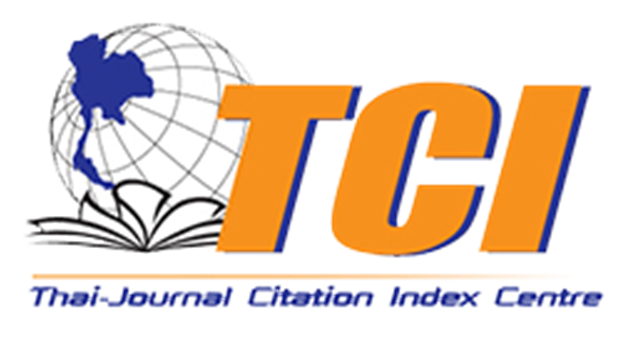Development of Cement Board from Concrete Mixed with Hemp Core as Fine Aggregate Substitute
การพัฒนาซีเมนต์บอร์ดจากคอนกรีตผสมแกนกัญชงเสมือนมวลรวมละเอียด
Abstract
งานวิจัยนี้เป็นการพัฒนาแผ่นซีเมนต์บอร์ดจากแกนกัญชงเสมือนมวลรวมละเอียดร่วมกับปูนซีเมนต์เป็นวัสดุประสาน โดยกำหนดอัตราส่วนทั้งหมด 5 อัตราส่วน ประกอบด้วยอัตราส่วนของปูนซีเมนต์ : ทราย : แกนกัญชง เท่ากับ 1 : 2 : 0.11, 1 : 2 : 0.12, 1 : 2 : 0.13, 1 : 2 : 0.14 และ 1 : 2 : 0.15 โดยน้ำหนัก ทำการทดสอบสมบัติทางกายภาพและสมบัติทางกลของแผ่นซีเมนต์บอร์ด ตามมาตรฐาน มอก. 878-2566 จากผลการทดสอบพบว่า มีค่าความหนาแน่นตั้งแต่ 1,752 ถึง 1,783 กก./ลบ.ม. ค่าความชื้นร้อยละ 2.37 ถึง 3.75 ส่วนค่ากำลังรับแรงดัด เท่ากับ 5.18 ถึง 6.81 กก./ตร.ซม. ที่อายุ 7 วัน และค่าความต้านทานของแรงดึงตั้งฉากกับผิวหน้าเท่ากับ 0.11 ถึง 0.18 กก./ตร.ซม. ที่อายุ 7 วัน โดยอัตราความชื้นและการพองตัว มีค่าผ่านเกณฑ์ตามมาตรฐาน มอก. 878-2566 ส่วนความหนาแน่น กำลังรับแรงดัด และแรงดึงตั้งฉากกับผิวหน้า มีค่าต่ำกว่ามาตรฐานที่กำหนด เนื่องจากลักษณะกายภาพของแกนกัญชงมีความพรุน ซึ่งลดการยึดเกาะระหว่างปูนซีเมนต์และแกนกัญชง พื้นที่สัมผัสระหว่างซีเมนต์และแกนกัญชงลดลง ทำให้แรงดัดและแรงดึงตั้งฉากลดลงตามการเพิ่มของปริมาณแกนกัญชง
This research focuses on the development of cement boards using hemp core as a fine aggregate substitute combined with cement as a binder. Five mix ratios were designed, consisting of cement: sand: hemp core ratios of 1 :2 :0.11, 1 :2 :0.12, 1 :2 :0.13, 1: 2: 0.14, and 1: 2: 0.15 by weight. The physical and mechanical properties of the cement boards were evaluated according to the Thai Industrial Standard (TIS) 878-2566. The results showed that the density of the boards ranged from 1,752 to 1,783 kg/m³, while the moisture content varied between 2.37% and 3.75%. The flexural strength was recorded at 5.18 to 6.81 kg/cm² at 7 days, and the tensile strength perpendicular to the surface ranged from 0.11 to 0.18 kg/cm² at 7 days. The moisture content and swelling values complied with the TIS 878-2566 standards. However, the density, flexural strength, and tensile strength perpendicular to the surface were below the specified requirements of the standard. This is attributed to the porous nature of the hemp core, which reduces the bonding between the cement and the hemp core. The decreased contact area between the cement matrix and the hemp core resulted in reduced flexural and tensile strength as the proportion of hemp core increased.
Keywords
[1] TIS 878-2566, Cement Bonded Particle Boards: High Density, 2023. (in Thai).
[2] S. Phantavee, T. Sinsiri, R. Somna, S. Akkaraikraisri and S. Khuptharat, Preliminary properties of concrete mixed with hemp core replacing coarse aggregate, The 12th Annual Concrete Technical Conference (ACC-Thailand 2017), Proceeding, 2017.
[3] P. Veeranukul and K. Suviro, Development of cement board sheets from coconut shell ash for energy and environmental conservation, Thesis, Rajamangala University of Technology Phra Nakhon, Thailand, 2015.
[4] E. Small and D. Marcus, Hemp: A new crop with new uses for north America, 2nd Ed., ASHS Press Inc., VA, USA, 2002.
[5] T. Jami, S.R. Karade and L.P. Singh, A review of the properties of hemp concrete for green building applications, Journal of Cleaner Production, 2019, 239, 117852.
[6] S. Phantavee, Preliminary properties of concrete mixed with hemp core replacing coarse aggregate, The 12th Annual Concrete Technical Conference (ACC-Thailand 2017), Proceeding, 2017.
[7] W. Thamcharee, Biocomposite materials, Bio and Nano, 40, 34-37. (in Thai).
[8] S. Inthata and C. Khankham, Use of rice straw for the production of thermal insulating cement boards, Thesis, Mahasarakham Rajabhat University, Thailand, 2019.
[9] https://urbannext.net/hemp-concrete/ (Accessed on 9 April 2023)
[10] TIS 2594-2567, Hydraulic Cement, 2024. (in Thai).
[11] W. Kroehong and S. Haruehansapong, Mechanical properties, thermal conductivity, and microstructure of hemp concrete, Science and Engineering Connect, 2020, 43, 91-102. (in Thai).
[12] ASTM C33, Standard Specification for Concrete Aggregates, ASTM International, PA, 2018.
[13] A.A. Pablo, Wood cement boards from wood wastes and fast-growing plantation species for low-cost housing, The Philippine Lumberman, 1989, 35, 8-53.
[14] M. Ardanuy, J. Claramunt, and R.D. Toledo Filho, Cellulosic fiber reinforced cement-based composites: A review of recent research, Construction and Building Materials, 2015, 79, 115-128.
[15] T. Sinsiri, S. Phantavee and P. Ratchakham, Production process of hemp concrete from hemp core mixed with fly ash, National Science and Technology Development Agency (NSTDA), 2017. (in Thai).
[16] S. Inthata, S. Attachariyakul and R. Chirawich, Study on the selection of building materials for energy-efficient homes, The 2nd Thailand Energy Network Conference (ENETT-Thailand 2017), Proceeding, 2006, 90-99.
[17] A. Karimah, M. Ridho, S.S. Munawar, D.S. Ismadi, R. Damayanti, B. Subiyanto, W. Fatriasari and A. Fudholi, Biomass waste materials through extrusion-based additive manufacturing: A systematic literature review, Journal of Materials Research and Technology, 2021, 13, 2442-2458.
[18] T. Pakkunwarakit, P. Phuthipairoj, W. Unjittichai and P. Thithawipat, Thermal Resistance Efficiency of Building Insulation Material from Agricultural Waste, Journal of Architectural/Planning Research and Studies, 2006, 4, 3-13. (in Thai).
[19] S. Phantavee, Development of concrete using hemp core as coarse aggregate by improving the quality with aluminum sulfate and calcium hydroxide and the impact of fly ash on hemp concrete, Thesis, Suranaree University of Technology, Thailand, 2017.
[20] G. Silva, S. Kim, R. Aguilar and J. Nakamatsu, Natural fibers as reinforcement additives for geopolymers – A review of potential eco-friendly applications to the construction industry, Sustainable Materials and Technologies, 2020, 23, e00132.
[21] L. Chen, Z. Chen, Z. Xie, L. Wei, J. Hua, L. Huang and P.S. Yap, Recent developments on natural fiber concrete: A review of properties, sustainability, applications, barriers, and opportunities, Developments in the Built Environment, 2023, 16, 100255.
DOI: 10.14416/j.ind.tech.2025.04.005
Refbacks
- There are currently no refbacks.






